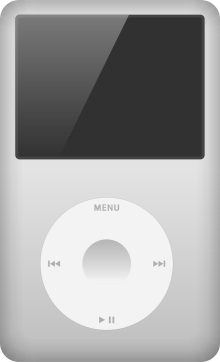
The iPod, a line of portable media players designed and marketed by Apple Inc., was first released in 2001. It became a cultural icon, revolutionizing the way people listened to music and consumed digital media. Although the advent of smartphones, particularly the iPhone, led to a decline in iPod sales, the late 2010s and early 2020s witnessed a resurgence in its popularity. This revival was driven by nostalgia, a renewed appreciation for dedicated music devices, and the growing interest in vintage technology.
Early iPod Culture
editThe iPod quickly gained popularity due to its sleek design, user-friendly interface, and substantial storage capacity, allowing users to carry thousands of songs in their pockets. Apple's marketing campaigns, featuring silhouetted dancers and white earbuds, played a significant role in establishing the iPod as a cultural icon. It became synonymous with personal freedom and modern technology, reflecting individual musical tastes.
Decline and Transition to Smartphones
editThe introduction of the iPhone in 2007 marked the beginning of the decline for standalone MP3 players. The iPhone’s multifunctionality, combining a phone, music player, camera, and internet device, led to a decrease in demand for dedicated music players like the iPod. The advent of the iPhone also brought the iPod touch, which was essentially a downgraded iPhone. The iPod touch became the new flagship of the iPod line despite its more limited storage options compared to the hard drive storage of previous iPods.[a] Following the introduction of the iPhone, the original iPod was remarketed as the iPod Classic with the sixth generation to differentiate it from the more feature-rich iPod touch. The sixth generation would be manufactured and sold until 2014. The Shuffle and Nano lines would continue to be manufactured (albeit, not updated) until 2017. The iPod touch, the final device in the iPod line, would later be discontinued in 2022.
Resurgence in the Late 2010s and Early 2020s
editDespite its decline, the iPod saw a resurgence in popularity in the late 2010s and early 2020s. This revival can be attributed to several factors:
- Nostalgia: Millennials and older generations who grew up with the iPod began to seek out these devices as a way to relive their youth. The tactile experience of the click wheel and the simplicity of a dedicated music player evoked a sense of nostalgia that resonated with many.
- Vintage Technology Trend: The broader trend of retro and vintage technology also played a role. Just as vinyl records experienced a comeback, so too did the iPod. Collectors and tech enthusiasts began to appreciate the iPod's design and functionality as a piece of technological history.
- Music Experience: Some music enthusiasts preferred the iPod's dedicated music-playing experience over the multifaceted but often distracting nature of smartphones. The iPod's focus on music without notifications and apps allowed for a more immersive and uninterrupted listening experience.
- Modification and Hacking: The iPod's resurgence was also fueled by a growing community of modders and hackers who upgraded old iPods with modern hardware, such as larger storage capacities and longer-lasting batteries. Websites, forums, and YouTube channels dedicated to iPod restoration and modification flourished during this period.
Impact on the Market and Culture
editThe renewed interest in iPods led to a surge in second-hand market activity. Platforms like eBay and specialized online stores saw increased demand for used and refurbished iPods. Some enthusiasts even opened businesses dedicated to iPod repair and restoration such as Elite Obsolete Electronics. The YouTube channel DankPods, created by Australian musician Wade Nixon, can be also be attributed to part of the resurgence of classic iPods.
Culturally, the iPod's comeback highlighted a shift towards valuing simplicity and specialization in a world dominated by multifunctional devices. It also underscored the enduring appeal of well-designed, purpose-built gadgets.
References
edit- ^ The iPod touch would finally surpass the storage capacity of the 160 GB classic with the 256 GB 7th generation iPod touch, introduced in 2019.
